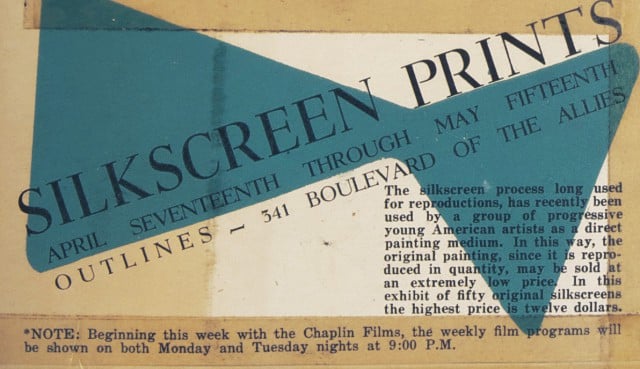Art World
Discovered: Certificate of Andy Warhol’s Birth (As an Artist)
THE DAILY PIC: Using silkscreens as paintings had roots in Warhol's youth.

THE DAILY PIC: Using silkscreens as paintings had roots in Warhol's youth.

Blake Gopnik


THE DAILY PIC: The world of Warhol studies is about to be rocked (or at least lightly tossed) by new revelations about his early exposure to avant-garde art in Pittsburgh.
A documentary by Pittsburghers Cayce Mell and Scott Sullivan, being launched at the Carnegie Museum of Art on May 21, is about to spell out the gloriously cutting-edge programming that went on in the city’s Outlines gallery, so far known more as a myth than a fact. The film unpacks a pair of scrapbooks that are all that are left of a space which, from 1941 to ’47 – the heart of Warhol’s teenagehood – hosted such radicals as John Cage, Joseph Cornell and Maya Daren, plus an endless, barely believable list of great modernists: Walter Gropius and Josef Albers, Edward Weston and Berenice Abott, even Langston Hughes and Joseph Campbell, who lectured to local worthies on James Joyce’s Finnegans Wake. Warhol could and would have seen them all. Is it any wonder that he went on to make great modern art?
A few weeks ago, however, when I was given a look at the scrapbooks themselves, those great names got me less excited than the modest-seeming object that is today’s Daily Pic: an announcement for a silkscreen show that might not seem that big a deal, beyond showing Warhol’s early exposure to what became his signature medium. But reading the invitation’s fine print made me realize that there was much more at stake: In just a few words, Betty Rockwell, founder of Outlines, mounts a powerful and idiosyncratic polemic that bills silkscreen as a medium for a new kind of specially democratic painting, rather than as just the latest in a line of printmaking techniques. And that is precisely the polemic mounted by Warhol two decades later and beyond, when the new-minted Pop artist used silkscreen as … a medium for a new kind of specially democratic painting.
As I’ve argued before, the greatness of Warhol lay as much as anything in his magical skills as a sponge, sucking up the ideas of others and spewing them out, much enhanced, as his own. But until the revelations gleaned from the new Outlines data (expect more in this space over coming weeks) who knew that his sponging began quite so early, and could wait for so long to pan out?
For a full survey of past Daily Pics visit blakegopnik.com/archive.